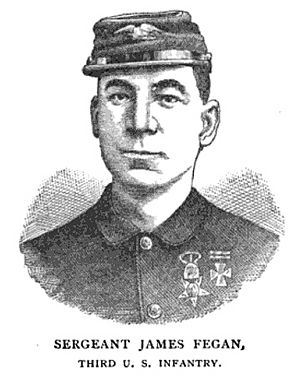James Fegan facts for kids
Quick facts for kids
James Fegan
|
|
|---|---|

Sergeant James Fegan illustration made in 1886
|
|
| Born | 1827 Athlone, Ireland |
| Died | June 25, 1886 (aged 59) Fort Shaw, Montana Territory, United States |
| Place of burial | |
| Allegiance | United States of America |
| Service/ |
United States Army |
| Years of service | 1851–1885 |
| Rank | Sergeant |
| Unit | 2nd U.S. Infantry 3rd U.S. Infantry |
| Battles/wars | American Civil War Indian Wars |
| Awards | Medal of Honor |
Sergeant James Fegan (1827 – June 25, 1886) was a brave American soldier. He served in the U.S. Army with the 2nd and 3rd U.S. Infantry regiments. He fought in important conflicts like the American Civil War and the Indian Wars.
In March 1868, James Fegan showed incredible courage. He was guarding a train carrying gunpowder. A group of people tried to blow up the train to free an army deserter (someone who illegally leaves the army). Fegan stopped them all by himself. For his heroic actions, he was given the Medal of Honor, one of the highest awards for bravery.
During his lifetime, Fegan was very well-known in the military. People admired his cleverness and sense of humor. Many funny stories were told about him. Even President Chester A. Arthur mentioned him in a special message to the United States Congress in 1882. His life story was featured in books like Uncle Sam's Medal of Honor (1886) and Sabre and Bayonet (1897).
Contents
Biography
Early Life and Joining the Army
James Fegan was born in Athlone, Ireland in 1827. Before moving to the United States in 1850, he worked with the Irish police force. After arriving in New York City, New York, he joined the U.S. Army as a private on October 29, 1851. He was assigned to Company I of the 2nd U.S. Infantry. By 1856, he had become a sergeant.
Fegan stayed with his unit during the American Civil War. He was part of the Army of the Potomac. He fought in many major battles, including Gaines' Mill, Malvern Hill, and Antietam. At Antietam, he was seriously wounded in his right leg. Even after being hurt, he joined the army again on March 31, 1864. He continued to fight bravely and was wounded several times. He took part in many important battles during the war's final years. These included the battles of Petersburg and the Appomattox Courthouse, where General Lee's army surrendered.
His Heroic Act at Plum Creek
After the Civil War, Fegan continued to serve in the Regular Army. He spent a lot of time serving on the frontier. In March 1868, he was given an important job. He had to guard a train of mules carrying gunpowder from Fort Harker to Fort Dodge, Kansas.
During this trip, Fegan caught an army deserter. He planned to turn the deserter in when they reached Fort Dodge. One night, while camping near Plum Creek, Fegan faced a challenge. Another soldier, Sergeant John W. Blake, had gathered a group of local townspeople. This group, called a posse, demanded that Fegan release the deserter.
Fegan refused to give up his prisoner. The angry group then tried to set the gunpowder on fire to force him to release the deserter. But James Fegan was incredibly brave. He faced the entire group by himself. He managed to scare them off, even wounding two of his attackers. Fegan then continued his journey to Fort Dodge. He arrived safely on March 13 with the gunpowder and the prisoner. Because of his bravery, the fort commander recommended him for the Medal of Honor. He received this prestigious award on October 19, 1868.
Later Years and Legacy
James Fegan continued to serve with the 3rd U.S. Infantry for many more years. After joining the army for the sixth time in 1870, he was sent to the Soldiers' Home in Washington, D.C.. However, he was later allowed to return to duty in the Montana Territory.
Fegan was a very popular person in his regiment. He was known for being smart and funny, and many stories were told about him. On December 6, 1882, President Chester A. Arthur even spoke about Fegan in a special message to the United States Congress. His life and military career were featured in books by author Theo F. Rodenbough.
Fegan's son, John Fegan, Jr., also joined the 3rd Infantry. He eventually became a sergeant, just like his father. James Fegan retired from active service on May 8, 1885, at Fort Missoula in the Montana Territory. He passed away a year later, on June 25, 1886, at Fort Shaw. He was 59 years old. James Fegan was buried at Custer National Cemetery in Montana.
See also

